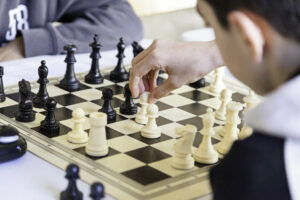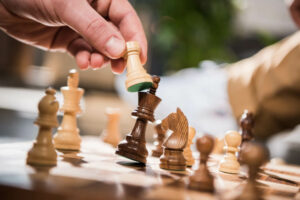Playing chess is a great way to challenge yourself and learn new strategies. If you’re just starting out, it can be overwhelming to figure out all the rules.
But don’t worry; we’re here to help! In this blog post, we’ll give you a simple introduction to the game of chess. You’ll learn how the pieces move, what the different pieces are called, and some basic strategy tips. So grab a board and some friends, and let’s get started!
How can I teach myself to play chess?
Learning to play chess can be an exciting and engaging experience. To get started, it is important to learn the basics of the game. Some resources to look into include books that offer a basic overview and videos that provide tutorials and helpful wise tips. With some dedication and effort, you can develop your skills by playing against others or with a computer program.
Additionally, if you are looking for more intensive practice in order to become an experienced player, consider joining a chess club or asking experienced friends to mentor you. With these useful strategies, anyone interested in learning chess will succeed if they remain persistent and patient with themselves as they grow in skill level.
What are the 5 important rules in chess?
Chess is a timeless and classic game that requires strategizing, thinking ahead, and quick reactions.
Every player must know the 5 important rules of the game in order to ensure they remain within the boundaries of fair play.
The first rule is the object of the game: each player’s goal is to checkmate their opponent’s king.
Rule number two states that pawns can only move forward, except when capturing an opposing piece by moving diagonally one square forward.
Rule number three states that while pieces can move any number of squares along a rank or file, they cannot jump over other pieces. Castling is also important in chess, as it allows the player to make two moves with their king and rook simultaneously.
The fourth rule stipulates that both pieces should not have moved before castling can be performed.
Finally, rule number five outlines that once a player has released their hand from a piece, it can no longer be taken back unless it was under another piece at the point when the hand was released. Knowing these essential rules will help you stay ahead in chess!
How does each piece move in chess?
Chess is a classic game that has been entertaining many for centuries. All the pieces on the board have their own movements that make each piece unique in its own way: The King and Queen move in any direction, but only one square at a time.
The Rooks travel horizontally and vertically, while the Bishop moves diagonally. The Knights move in an L-pattern, jumping to adjacent squares that are not obstructed by any other chess piece; it is the only military unit than can jump over other pieces.
Finally, the Pawns progress forwards one space every turn with two special exceptions: on its first move it may advance two spaces, and it captures opponents’ pieces diagonally instead of moving straight forward. Each piece possesses its own abilities on the chessboard; understanding them is key to mastering this beloved strategy game.
What is the best first move in chess?
The best first move in chess is a matter of considerable debate among experts. While some argue that the best move is to control the center of the board with either a knight or pawn, others suggest opting for an offensive strategy and attacking your opponent immediately.
No matter what approach you take, the goal is to gain a positional advantage so it’s important to recognize opportunities throughout the game for setting up future moves.
One classic opening many players utilize is the King’s Indian Defense, which involves protecting your king by quickly pushing two pawns on either side of him and castleing if possible. Ultimately it comes down to personal preference, understanding your own style, and anticipating your opponent’s likely plays.
What happens when 2 kings meet in chess?
When two kings meet on the chessboard, it is said to be a draw as no further moves are available to either side.
This stalemate can happen in any other game such as checkers, since both players have already utilized their pieces and there is nothing left to do but accept defeat.
The rule that applies when it comes to two kings on the board ultimately teaches a valuable lesson about the importance of selecting the right pieces at the right time and how even seemingly unbeatable combinations can still result in a deadlock if misused or mistimed.
Each strategy is valuable and delicate – even something so simple as two kings coming face-to-face has its own place and importance in the greater scope of playing chess.
Conclusion
Chess is an incredibly complex game with many rules and conventions to learn. However, it is also extremely rewarding and provides unique challenges every time you play.
Once you are comfortable with the fundamentals of the game and how each piece moves, honing your skills is as simple as playing against an opponent either online or in person. Of course, there are tricks, such as focusing on the importance of pawn structure and development in the opening moves and emphasizing king safety after castling.
And no matter how intense a match may become, never forget that when two kings meet in chess – the game ends in a draw. With practice, patience, and mastery of these ideas, you can learn how to play chess and become an expert at this captivating game.




